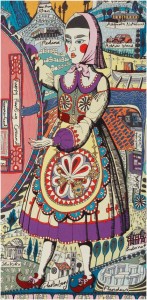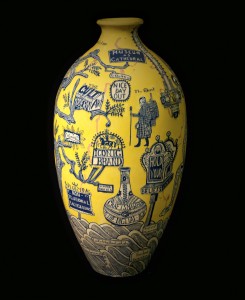You have no items in your cart. Want to get some nice things?
Go shoppingGrayson Perry’s art was never going to be ‘normal’ or ‘nice’. He is a transvestite whose alter ego, Claire, likes to dress up in dolly outfits, bibs and bonnets. He holds balloons sometimes. He wears bright red lipstick. He also won the Turner prize in 2003 and is one of the most iconic artists on the modern art scene.

As you walk into his exhibition in the British Museum, you see a vase called ‘You Are Here’. A scruffy hipterish looking gent is engraved onto the vase, a speech bubble reading ‘It got cool reviews on Time Out’. A particularly beautiful and polished lady (with a Chanel handbag in tow) says ‘There was such a buzz about it on twitter’. Grayson Perry is not being serious about these people – it is his sarcastic irony that keeps him alive, his ability to make fun of Londoners and people’s fascination with society and up-keepings that makes him popular. He is cheeky. He is avant-garde.
‘Tomb of the Unknown Craftsmen’ is a thought-provoking and meaningful exhibition. Grayson has used his 51 year old Teddy, Alan Measles (great name) as the subject of his exhibition, and created several shrines, mini monuments and sculptures dedicated to Alan, alongside ancient artifacts found in various places around the world. The point is that all these ancient artefacts are created by unknown craftsmen. It’s about pilgrimage. It’s about love for antiquities, the things people long dead have left behind for future generations. Grayson’s ‘Rosetta’ vase is a 21st century homage to the original Rosetta Stone, which resides in the British Museum (written in ancient Greek and Egyptian, it tells the story of the past). The vase uses words such as ‘iconic brand’ and ‘non traditional backgrounds’ to showcase the modernity of our times – it is a true zeitgeist of our social generation.

Grayson has never travelled to Africa, but he has created a vase about it – entitled ‘I have never been to Africa’. The description reads: ‘When I think of Africa, I feel guilt and fear’, which is probably the most poignant and alarmingly true statement anyone could make of Africa (if you haven’t been, that is). The developing world’s view of Africa is often of hunger, misfortune and extreme poverty; we watch all the documentaries and charity adverts and news reports in our comfortable middle class homes with two cars in the driveway. But more than making viewers aware of Africa guilt, Grayson is also illuminating the fact that places such as the British Museum helps us develop an understanding of the place. We are able to connect with Africa through historical pieces on display at the museum.
Walking through the muted rooms of artifacts and vases, there is a sense of an important narrative being unfolded and told to you exclusively. The descriptions on the pieces could have been lifted straight from Grayson Perry’s own diary/journal.
It’s a museum exhibition about museums and their exhibitions. Definitely worth a visit.
The show is due to run until 19 Feburary 2012.
Ysabelle Cheung





